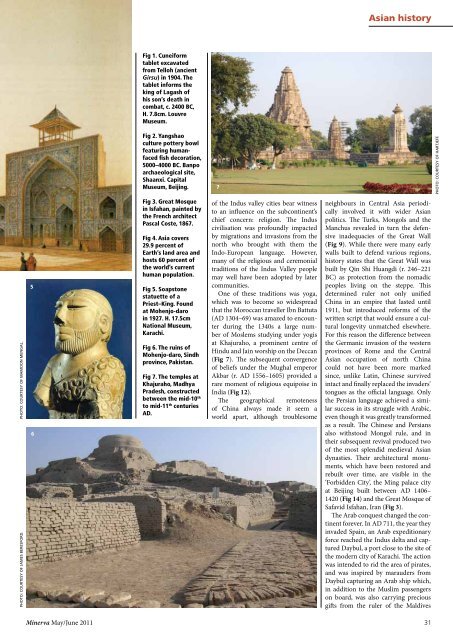Cult of beauty - Minerva
Cult of beauty - Minerva
Cult of beauty - Minerva
You also want an ePaper? Increase the reach of your titles
YUMPU automatically turns print PDFs into web optimized ePapers that Google loves.
Photo: courtesy <strong>of</strong> mamoon mengal.<br />
Photo: courtesy <strong>of</strong> james beresford.<br />
5<br />
6<br />
<strong>Minerva</strong> May/June 2011<br />
Fig 1. Cuneiform<br />
tablet excavated<br />
from Telloh (ancient<br />
Girsu) in 1904. The<br />
tablet informs the<br />
king <strong>of</strong> Lagash <strong>of</strong><br />
his son’s death in<br />
combat, c. 2400 BC,<br />
H. 7.8cm. Louvre<br />
Museum.<br />
Fig 2. Yangshao<br />
culture pottery bowl<br />
featuring human-<br />
faced fish decoration,<br />
5000–4000 BC. Banpo<br />
archaeological site,<br />
Shaanxi. Capital<br />
Museum, Beijing.<br />
Fig 3. Great Mosque<br />
in Isfahan, painted by<br />
the French architect<br />
Pascal Coste, 1867.<br />
Fig 4. Asia covers<br />
29.9 percent <strong>of</strong><br />
Earth’s land area and<br />
hosts 60 percent <strong>of</strong><br />
the world’s current<br />
human population.<br />
Fig 5. Soapstone<br />
statuette <strong>of</strong> a<br />
Priest–King. Found<br />
at Mohenjo-daro<br />
in 1927. H. 17.5cm<br />
National Museum,<br />
Karachi.<br />
Fig 6. The ruins <strong>of</strong><br />
Mohenjo-daro, Sindh<br />
province, Pakistan.<br />
Fig 7. The temples at<br />
Khajuraho, Madhya<br />
Pradesh, constructed<br />
between the mid-10 th<br />
to mid-11 th centuries<br />
AD.<br />
7<br />
<strong>of</strong> the Indus valley cities bear witness<br />
to an influence on the subcontinent’s<br />
chief concern: religion. The Indus<br />
civilisation was pr<strong>of</strong>oundly impacted<br />
by migrations and invasions from the<br />
north who brought with them the<br />
Indo-European language. However,<br />
many <strong>of</strong> the religious and ceremonial<br />
traditions <strong>of</strong> the Indus Valley people<br />
may well have been adopted by later<br />
communities.<br />
One <strong>of</strong> these traditions was yoga,<br />
which was to become so widespread<br />
that the Moroccan traveller Ibn Battuta<br />
(AD 1304–69) was amazed to encounter<br />
during the 1340s a large number<br />
<strong>of</strong> Moslems studying under yogis<br />
at Khajuraho, a prominent centre <strong>of</strong><br />
Hindu and Jain worship on the Deccan<br />
(Fig 7). The subsequent convergence<br />
<strong>of</strong> beliefs under the Mughal emperor<br />
Akbar (r. AD 1556–1605) provided a<br />
rare moment <strong>of</strong> religious equipoise in<br />
India (Fig 12).<br />
The geographical remoteness<br />
<strong>of</strong> China always made it seem a<br />
world apart, although troublesome<br />
Asian history<br />
neighbours in Central Asia periodically<br />
involved it with wider Asian<br />
politics. The Turks, Mongols and the<br />
Manchus revealed in turn the defensive<br />
inadequacies <strong>of</strong> the Great Wall<br />
(Fig 9). While there were many early<br />
walls built to defend various regions,<br />
history states that the Great Wall was<br />
built by Qin Shi Huangdi (r. 246–221<br />
BC) as protection from the nomadic<br />
peoples living on the steppe. This<br />
determined ruler not only unified<br />
China in an empire that lasted until<br />
1911, but introduced reforms <strong>of</strong> the<br />
written script that would ensure a cultural<br />
longevity unmatched elsewhere.<br />
For this reason the difference between<br />
the Germanic invasion <strong>of</strong> the western<br />
provinces <strong>of</strong> Rome and the Central<br />
Asian occupation <strong>of</strong> north China<br />
could not have been more marked<br />
since, unlike Latin, Chinese survived<br />
intact and finally replaced the invaders’<br />
tongues as the <strong>of</strong>ficial language. Only<br />
the Persian language achieved a similar<br />
success in its struggle with Arabic,<br />
even though it was greatly transformed<br />
as a result. The Chinese and Persians<br />
also withstood Mongol rule, and in<br />
their subsequent revival produced two<br />
<strong>of</strong> the most splendid medieval Asian<br />
dynasties. Their architectural monuments,<br />
which have been restored and<br />
rebuilt over time, are visible in the<br />
‘Forbidden City’, the Ming palace city<br />
at Beijing built between AD 1406–<br />
1420 (Fig 14) and the Great Mosque <strong>of</strong><br />
Safavid Isfahan, Iran (Fig 3).<br />
The Arab conquest changed the continent<br />
forever. In AD 711, the year they<br />
invaded Spain, an Arab expeditionary<br />
force reached the Indus delta and captured<br />
Daybul, a port close to the site <strong>of</strong><br />
the modern city <strong>of</strong> Karachi. The action<br />
was intended to rid the area <strong>of</strong> pirates,<br />
and was inspired by marauders from<br />
Daybul capturing an Arab ship which,<br />
in addition to the Muslim passengers<br />
on board, was also carrying precious<br />
gifts from the ruler <strong>of</strong> the Maldives<br />
31<br />
Photo: courtesy <strong>of</strong> hartjeff.

















